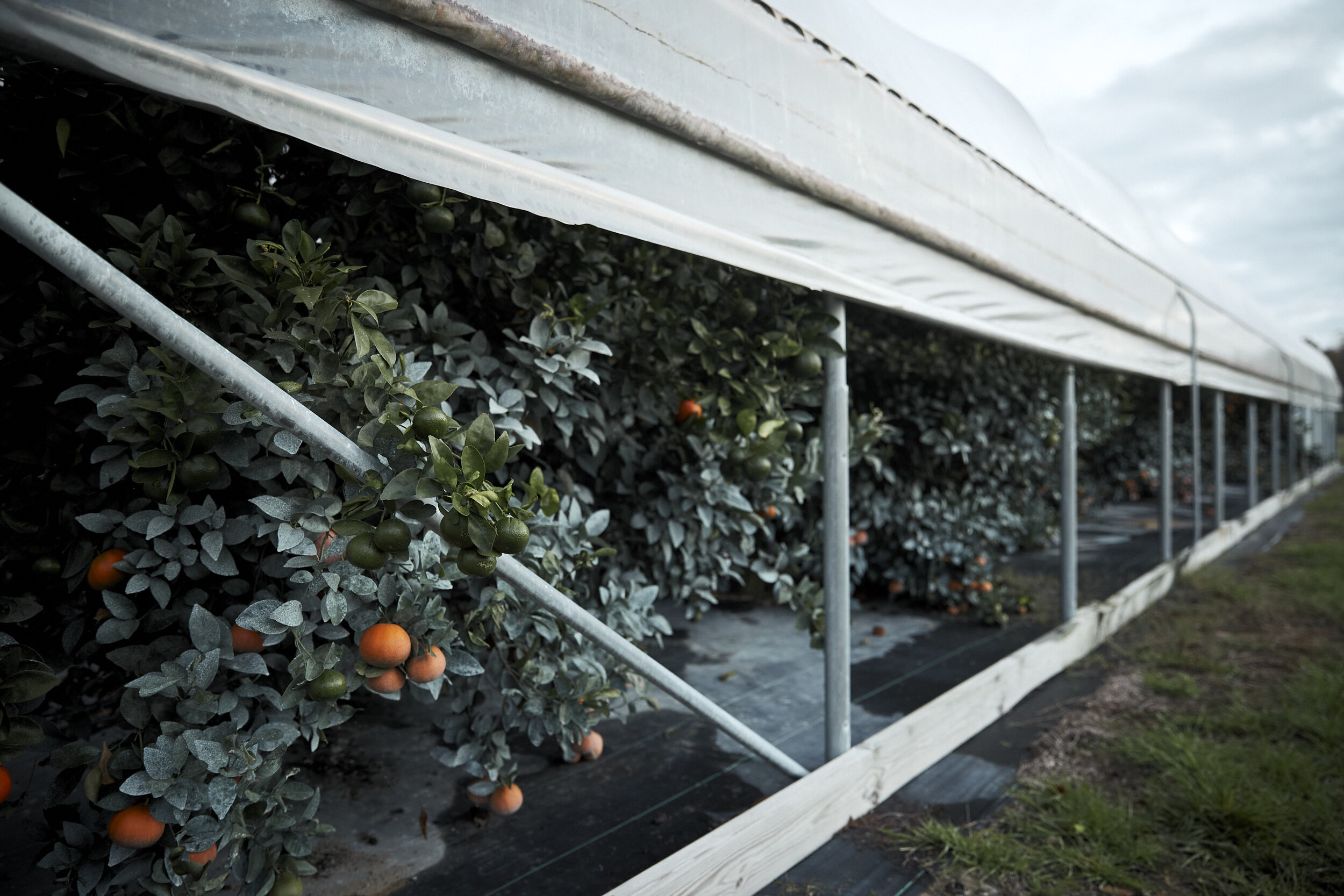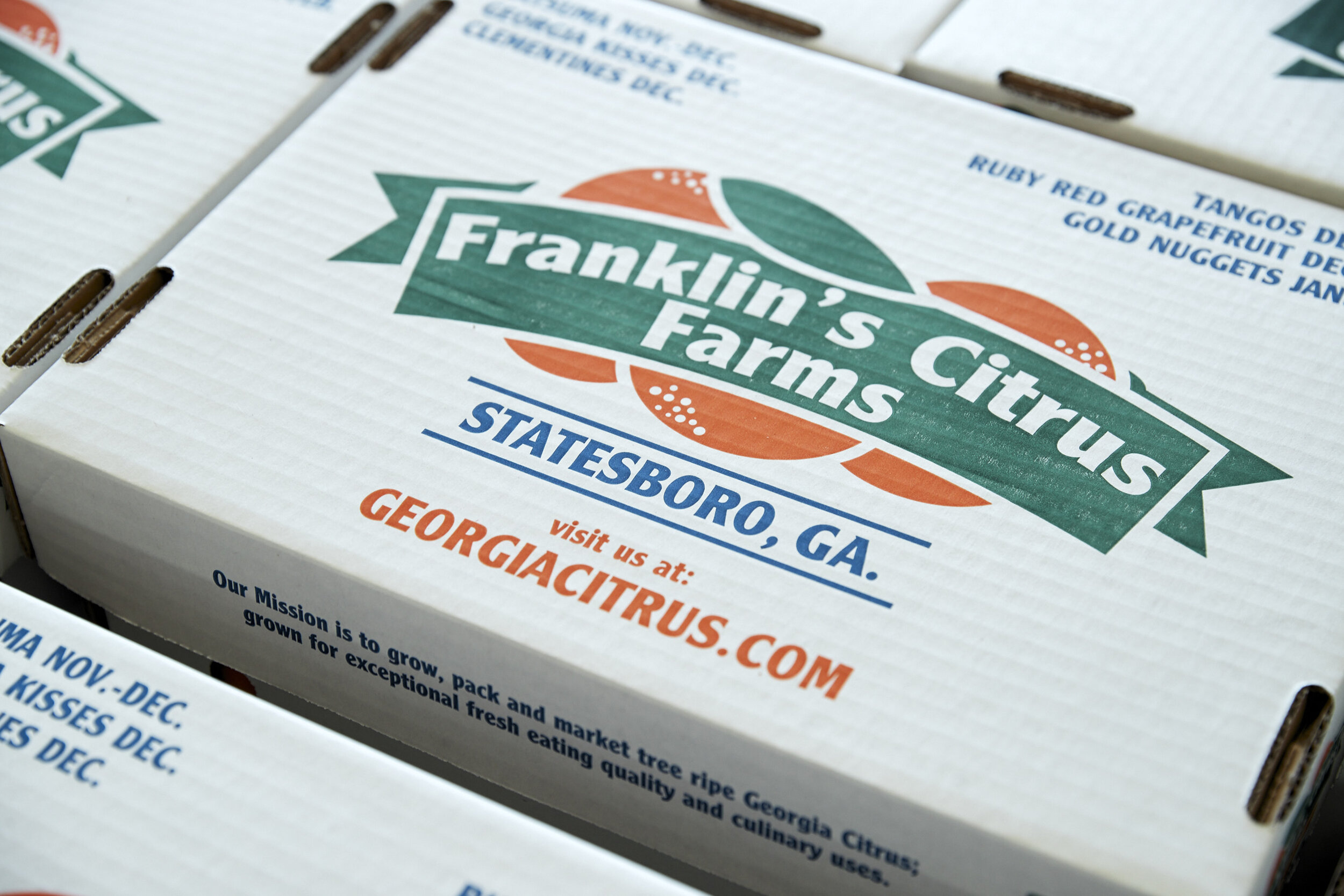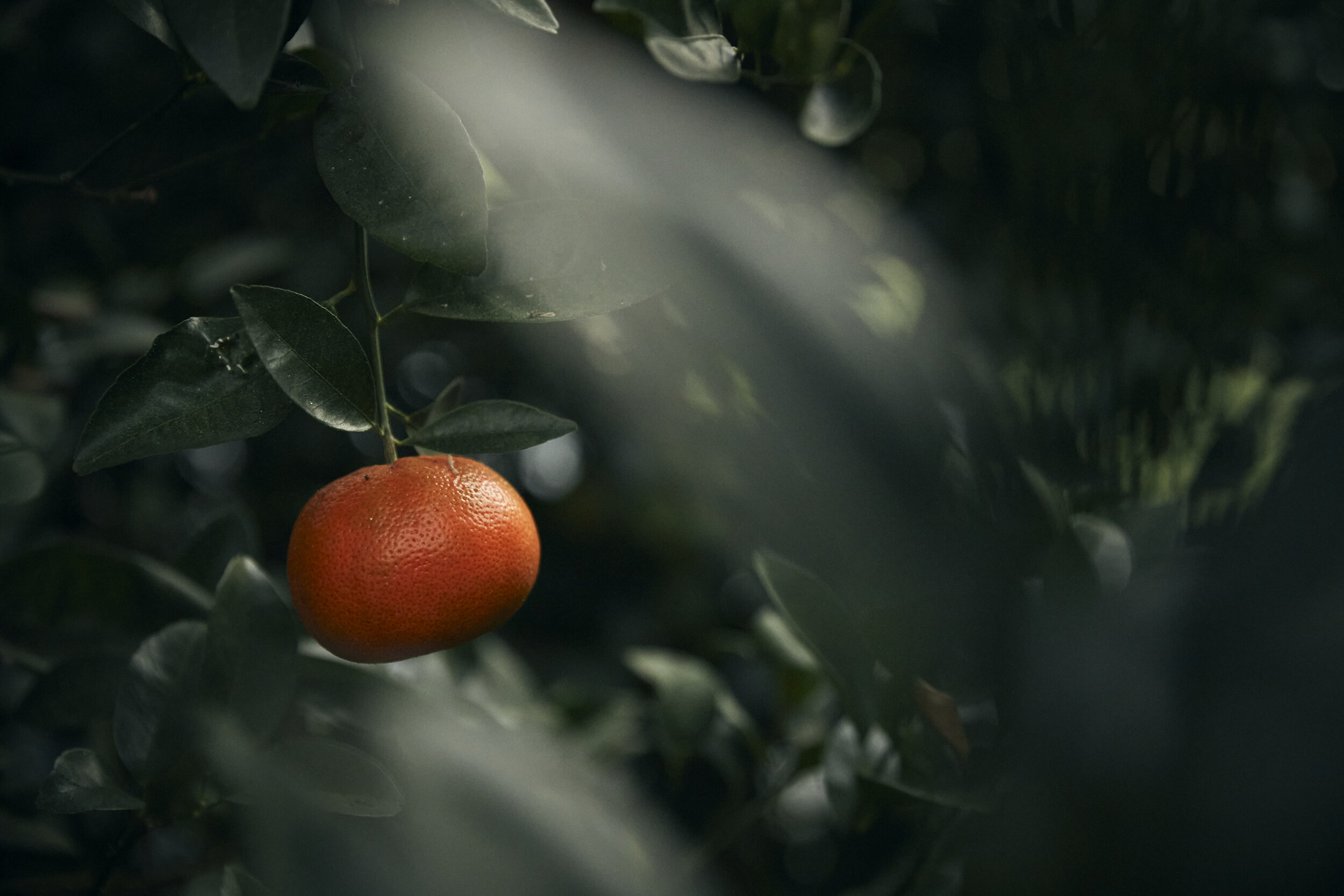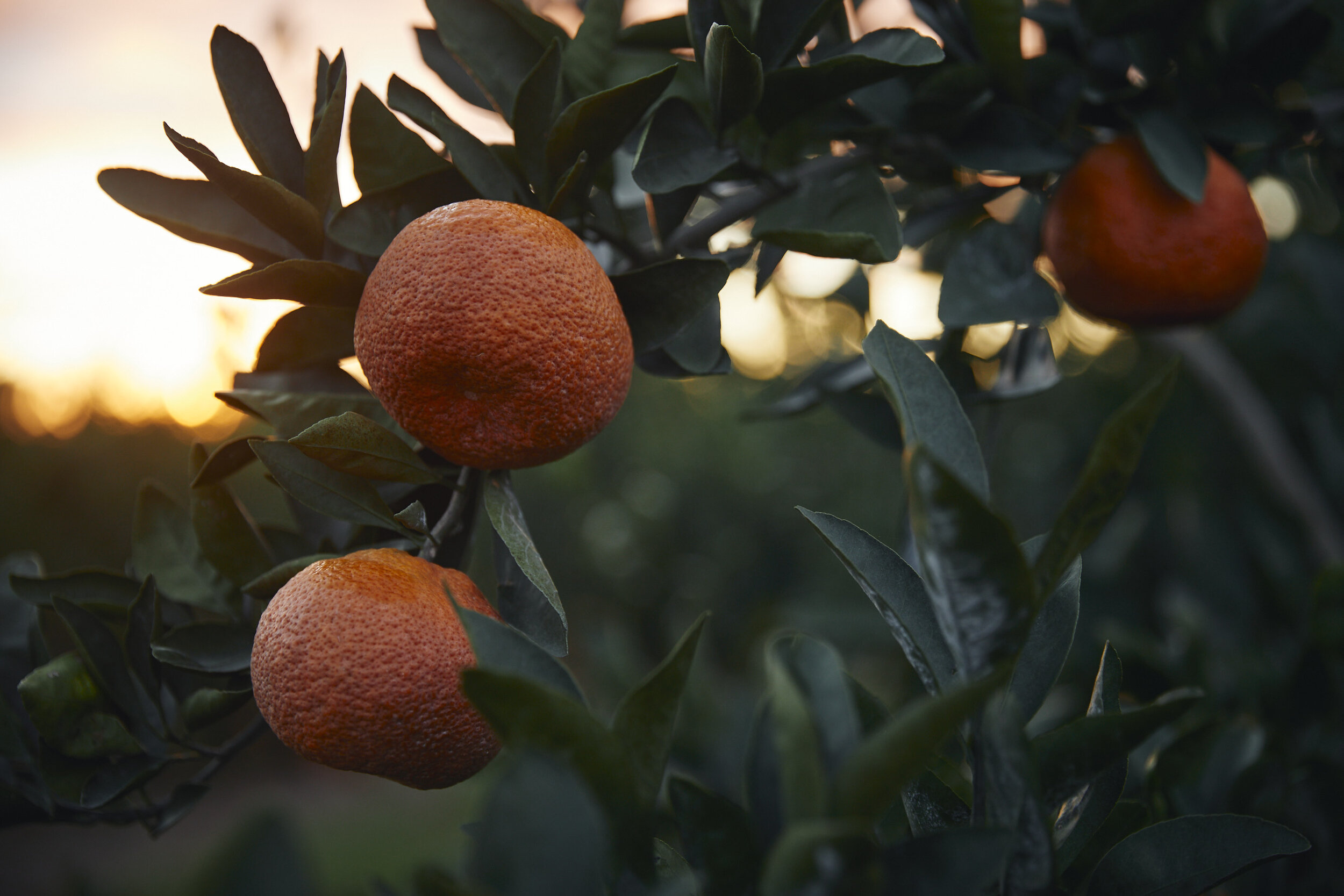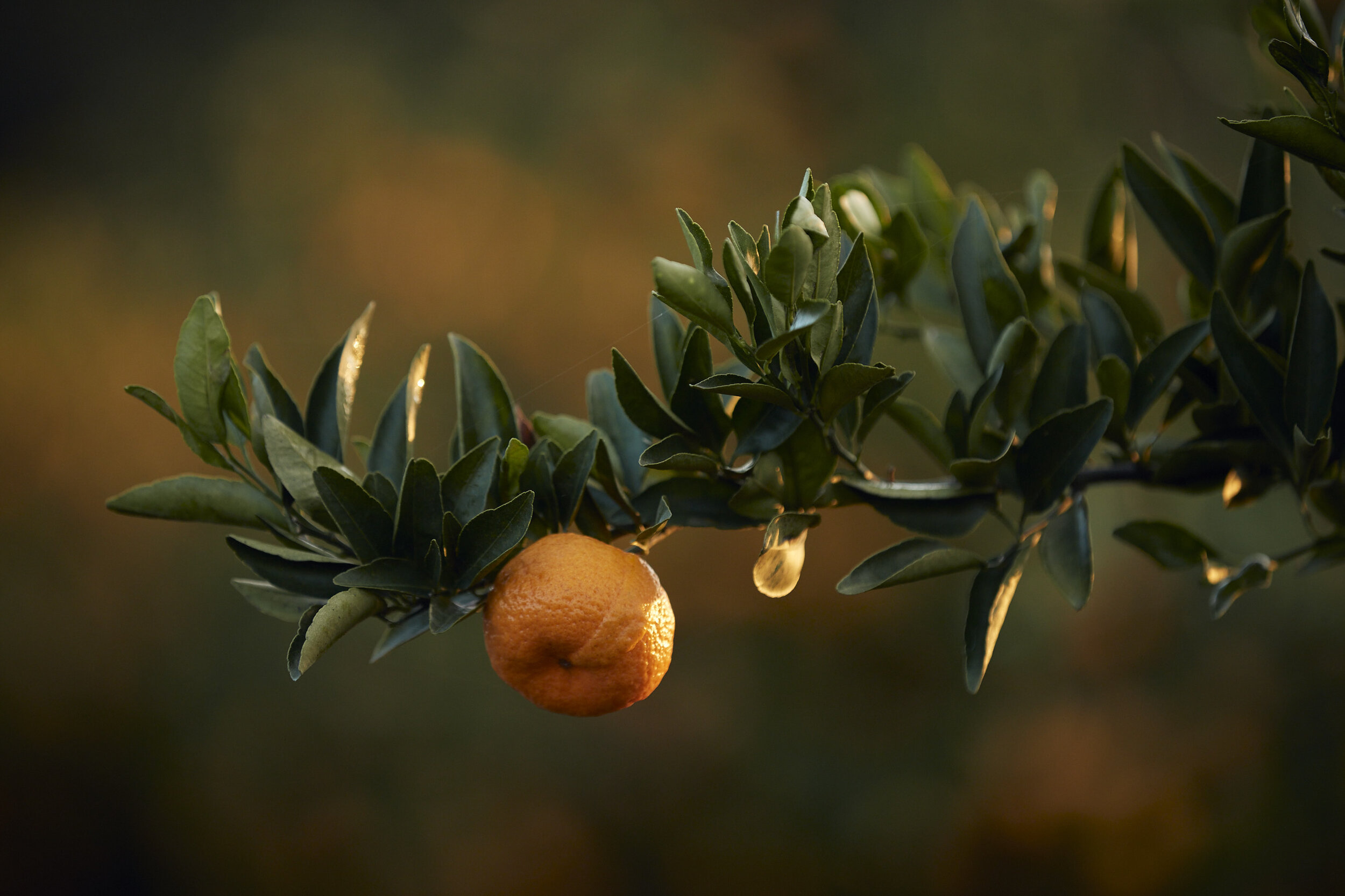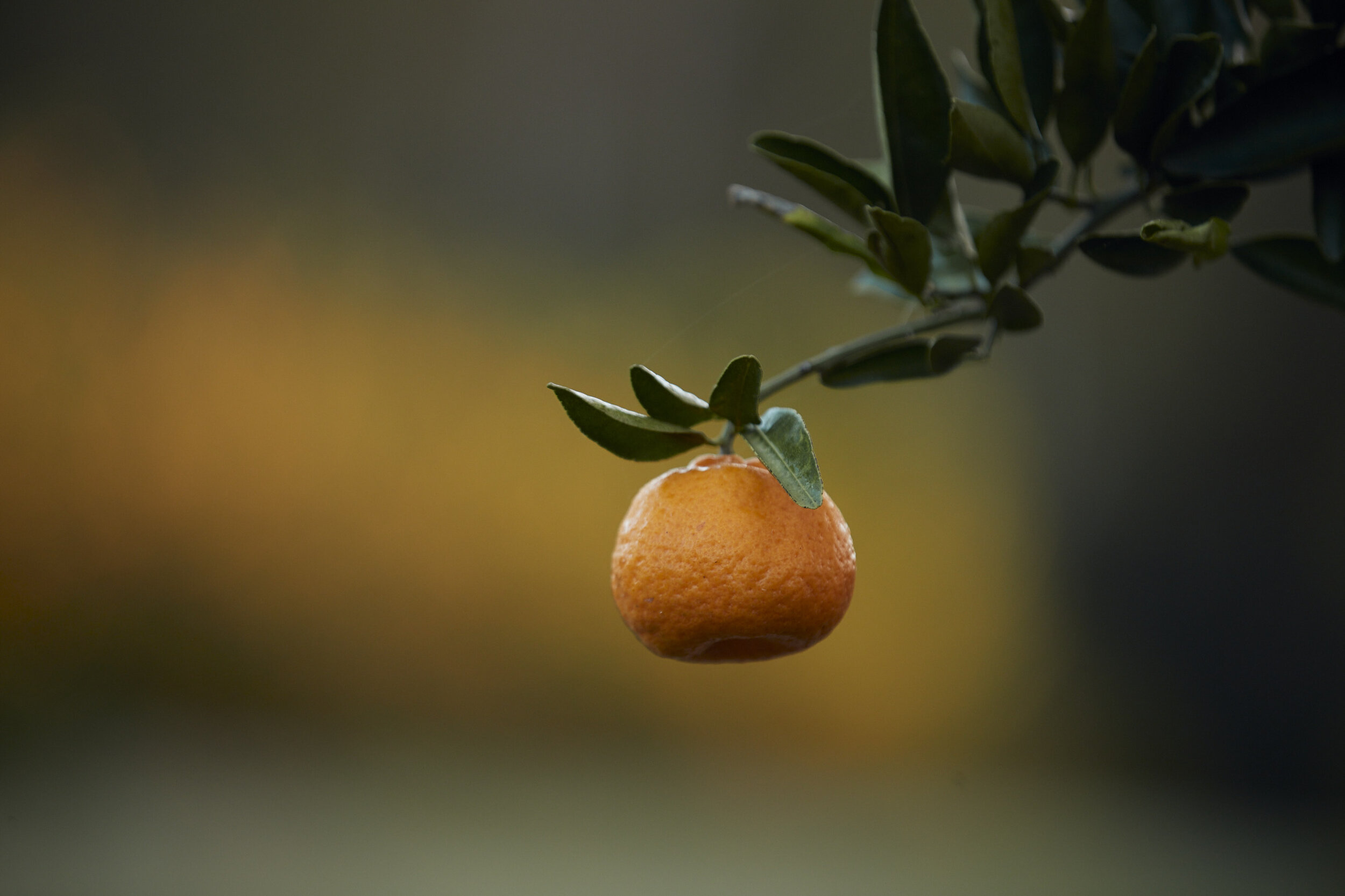Story by James Murdock | Photographs by Gregory Miller
Southern winters have been getting warmer. Ten years ago, Joe Franklin started growing citrus on his farm in Statesboro, Georgia — a place where no one expected oranges to grow. Now, Franklin’s citrus groves teem with life and might actually help, in a very small way, to combat climate change.
”There’s nothing in south Georgia, people will tell you, except straight, lonely roads, one-horse towns, sprawling farms, and tracts of planted pines. It’s flat, monotonous, used-up, hotter than hell in summer, and cold enough in winter that orange trees won’t grow.”
— Janisse Ray, Ecology of a Cracker Childhood, 1999
A blaze of orange, a tropical tone in winter, glowed from a dark corner of my mother’s kitchen. Tiny heads of fresh citrus formed a delicious mound in a ceramic bowl. Lively leaves perked from their stems as if still reaching toward the sun. Too lively, I thought, to have made the trip from Florida.
“Where’d you get these?” I asked.
“A man in Statesboro grows them,” Mom said. “He’s got a stand on 301.”
“A man grows these here?”
“Yeah. I guess we can grow them here, now.”
I spent the first 18 years of my life in south Georgia and never saw a single orange tree. I thought Mom must be mistaken, but she assured me. Confused by this, I kept a suspicious eye on the fruit. And I ate a few. Each tiny segment, robust with sweet, tangy juice, enticed me more.
My hometown of Metter lies in Georgia’s upper coastal plain, 100 miles, as the crow flies, north of Florida. Though the region is part of a landmass that falls gracefully from the hilly Piedmont to the ocean, it is nowhere close to the traditional citrus belt of central Florida.
Each time I glanced at the fruit, Mom’s words, I guess we can grow them here, now, roamed around my brain like a moody raccoon. A feeling of dread, but also curiosity, arose. I needed to talk to that farmer out on U.S. Route 301.
A variety of citrus fruits are cultivated at Franklin’s Citrus Farm in Statesboro, Georgia, in a region that was once too cold for citrus to survive. Kishus, or “Georgia Kisses,” are clipped from the tree with the leaves left attached to their stems to prevent the delicate fruit from falling out of its loose, easily-peeled skin.
The bottom of Joe Franklin’s shirt pocket holds an ink stain; his mind moves too busily for bleeding pens. He sports white tennis shoes and a scruffy mustache, from which a strong septuagenarian voice pushes patient words. When I asked to visit in his free time, he said, “When you work with citrus, there is no free time.”
Still, he welcomed me on a Saturday in mid-harvest.
When we meet, Franklin is agitated. A delivery driver flaked on him, and the clock ticks at a market in Savannah. His blue eyes squint over a cell phone as he paces, and I know to stay out of the way.
Franklin’s office, a tin building doubling as a packing center, swims with relics of fishing expeditions. I examine some color-drained photographs, groups of men smiling behind bounties of pickerel, and I’m drawn toward an open sunny garage door to inspect the scenery on the other side of the office.
Joe Franklin sits at his desk, amid stacks of cardboard packing boxes in his office, fielding calls from interested buyers. As his Bulloch County citrus farm expands, more people are learning that growing citrus in Georgia is possible.
The sky is cloudless, and an aroma of peroxide and citrus peel lingers in the warm winter air. Out in the light, long rows of glossy trees disappear into a backdrop of sycamore and pine. I have entered a strange dimension, I think, where two typically distinct environments merge into one bizarre ecotone.
I imagined finding a few ugly trees clinging to life. What I discover is a full-scale citrus farm where citrus farms do not belong. As far as I can see, trees gushing with bright globes bask in the sunlight. Voices interrupt my trance. A younger reddish blonde-haired man breaks the tension with news that the driver has come and gone. Franklin breathes, knowing his citrus will make it to Forsyth Farmers’ Market in Savannah.
The morning is born again.
“This is Billy,” Franklin says, introducing me to his farm manager, Bill Renz, and the three of us head outside.
We walk into an open-ended hoop house where a jungle of fully grown orange and grapefruit trees press against one another, jockeying toward the sunlit ceiling. A country ringtone blares from Renz’s phone. Franklin begins to tell his story while Renz disappears into rustling branches.
Several hoop houses on Franklin’s farm serve as insurance policies, providing backup fruit if a winter storm kills grove trees (which has not happened yet). The houses are also sites of experimentation, and new varieties that fare well under cover are often introduced outdoors. The chalky material seen here on the leaves is kaolin clay, a native Georgia mineral, which is sprayed on to protect trees and fruit from harsh sun exposure. As an added bonus, kaolin also acts as a natural insect deterrent.
In the spring of 2009, Franklin and his fishing buddies headed to Louisiana seeking redfish, but he found his destiny. Folks sold Satsumas from nearby family orchards out of the backs of pickups. Curious, having never heard of the sweet loose-skinned mandarin orange, they pulled over to buy a bag.
“It was the best piece of citrus I’ve ever put in my mouth,” Franklin says. He pulls an orange from overhead and opens his pocket knife.
When he returned home, he researched how to raise the trees, which have been cultivated for centuries in Japan. No information on growing Satsumas in his climate zone existed, but Franklin’s curiosity would not let up. The next spring he bought 200 Satsuma seedlings, for $21 each, and planted them himself on a small plot of his family farm.
This was no meager experiment, considering the price for the trees alone added up to over $4,200. With site prep, irrigation, and fertilizer, Franklin’s little experiment cost in the ballpark of $10,000. Having no research-based information on how the trees might react to this environment, on what chemical regiments were required here, on how weather patterns might affect the tree’s production, this project was more gamble than investment. Satsumas take three to four years to produce edible fruit. Years would pass before Franklin could taste the fruit of these young trees. He rolled the dice anyway. If there was a chance he could grow what he tasted in Louisiana, it would be worth the risk.
In his younger years, Franklin raised beef cows on the land that he inherited. In 1979, he purchased an additional 100 acres, bringing the farm to a total of 450. After the beef trade became more heavily regulated, he leased his fields to local farmers who grew peanuts and soybeans. Franklin tried his hand at growing soybeans once, but was never crazy about growing crops that came with prices dictated by global markets. He always searched for something else.
Franklin passes me a slice of a Page orange, and Renz explains that these oranges must be cut open, the peel contains oil which corrupts the eating experience if broken by hand. Renz is a reservoir of citrus knowledge. “Page oranges were popular in the ’70s and ’80s,” he tells me. “They fell off because they’re seedy and hard to peel. And because of the oil. Breeders use them these days to sweeten things up; they cross other oranges with Page to try and pass on its flavor.”
The Page slice tastes so sweet, it reminds me of orange-flavored candy — like it’s sprinkled with processed sugar. I bite and juice pours out of the corner of my mouth.
Franklin points at trees and says names I’ve never heard. Oroblanco grapefruit from Israel, Dekopons from Japan, and Australian finger limes. He cuts open a finger lime and squeezes it over my palm. Luscious little morsels fall like tiny pearls into a pile. These limes sell for up to $174 a pound online. “Citrus caviar,” Franklin says.
One of the many varieties found in Franklin’s hoop houses is the Australian finger lime, which sells for up to $174 a pound online. When the fruit is cut open and squeezed, tiny, ball-shaped juice kernels fall out. This popular culinary variety is known as citrus caviar.
Renz explains that the hoop house is both a site of experimentation and an insurance policy. If a killer winter storm rolls in, the houses provide backup fruit. But they mainly serve as research centers. Franklin and Renz are not just farmers; they are effectively scientists.
Renz grew up in citrus country, in the small southwest Florida town of Alva. As a kid, with 30-foot orange trees in his yard, he’d whack fruit with a baseball bat into fields to feed cows. A decade ago, about the time Franklin planted his first trees, Renz and his family moved to Statesboro, Georgia. He had just landed a job managing a local nursery, which grows flowers and ornamentals.
One fateful summer day in 2010, Franklin wandered into the nursery to browse plants, not in search of anything citrus related. Renz struck up a conversation that eventually led to Franklin telling him about his little experiment. Renz was fascinated and drove right over after work to check it out.
Within weeks, Renz became a citrus consultant for Franklin, sharing valuable knowledge as the trees grew. He started helping on weekends, and soon Franklin hired him as a part-time farmhand.
“The first pickers were me, Joe, and a couple of his buddies,” Renz says, laughing. “We were like, ‘What the hell are we going to do with these things?’”
Recently, Franklin gave Renz half the business and made him a partner. As the farm adds thousands of new trees a year, Renz oversees the expansion, as well as everything from shipping to marketing. His teenage daughter, Shaylee, takes pictures for the farm’s social media sites, and his wife, Lauren, works markets on weekends.
Joe Franklin and Bill Renz are partners of Franklin’s Citrus Farm. Renz moved to Statesboro from Florida in 2010, the same year Franklin planted his first trees; the two met in a local nursery Renz managed. Renz soon became a citrus consultant for Franklin, then a farmhand, then a partner.
Renz kept his job at the nursery, but after 10 years of managing the store, he’s taken on a new role of coordinating landscaping projects. He manages a team, based out of the nursery, that implements his designs. This role provides Renz more flexibility, now that Franklin’s Citrus is expanding. Still, during the three-month harvest, he works 70-80 hours a week, half at the nursery, half at Franklin’s.
Renz strategizes how to deliver their product to larger retailers — raising Franklin’s from farmers markets and its roadside stand on U.S. Route 301 to grocery chains across the country. The farm supplies a variety of citrus — Kishus, Tangos, Satsumas, lemons, and grapefruits — to more than 20 small produce vendors and to markets in multiple states. Drivers who buy truckloads of citrus from Franklin’s deliver their fruit as far north as Philadelphia and as far west as Oklahoma.
Outside of the hoop house lies a serene morning. It’s quiet for mid-harvest, and I search for teams of roving pickers in the orchards. With more than 6,500 trees, 53 acres of citrus, plenty of work awaits. A few songbirds fly by; nothing else moves.
The 25 people who pick for Franklin’s Citrus are all members of the Ventura family, who live in a nearby community. They work six days a week during harvest from sunup to dusk, loading citrus into large front-heavy bags strapped to their shoulders. They cut kishus, what Franklin calls “Georgia Kisses,” from branches with needle-nose clippers to keep the tiny delicate fruit from slipping out of its loose-skinned peels. They pack thousands of boxes a week. But not on Saturdays, even with retailers calling. As Seventh Day Adventists, the Venturas will not be photographed and spend the daylight hours of their Sabbath in worship.
In the late 1880s, Satsumas became popular in the Gulf, thanks to an Irish-born painter named Anna Schoyer. While on a cultural mission in Japan during the Meiji Restoration, Schoyer met two loves, Robert Bruce Van Valkenburgh, the U.S. Ambassador to Japan, and the lovely palm-sized fruit “unshu mikan” on Kyushu Island. We call the fruit Satsuma because of Schoyer, who named it for the samurai-ruled province where she first tasted its sweetness.
After marrying in Japan, Schoyer and Van Valkenburgh had a two-story carpenter Gothic abode built, overlooking St. Johns River outside of Jacksonville, Florida. Schoyer longed for the fruit she had tasted while abroad, and soon after the house was finished, in 1878, she had 75 Owari Satsuma trees delivered from Kyushu Island to her doorstep. She and her husband planted the trees directly behind their house amid long drooping branches of live oaks on their 18-acre estate.
Satsumas became a celebrated centerpiece at the couple’s dinner parties, and soon, news that the seedless mandarin was cold-hardy enough to grow in north Florida spread. The fruit gained popularity among consumers for its sweet taste and easily peeled skin, and growers across the Gulf sought to meet new demands. By 1890, more than a million Satsuma trees stood in groves from Florida to Texas. A group of growers established the Gulf Coast Citrus Exchange, built solely around Satsumas, which delivered the fruit as far north as New York.
But this young boom would lack the hardiness required for survival.
Several brutal winters, beginning in the late 1890s, swept through the region killing trees. Growers learned quickly that the cold-hardiness of Satsumas had limitations. After the 1890s, the industry rebounded, but more devastating winters hit in the 1910s. Then more in the 1930s. Each string of deep freeze decimated groves across the gulf and crippled the young industry. Growers were resilient; the trees were not.
“The winter of 1935 did them in,” Franklin says, as we stand among his Satsumas. He speaks about this in a pleasant tone, like what happened then is somehow unrelated to the trees that make up the majority of his farm. I wonder if he shouldn’t be more disheartened by this story.
“You’re not worried that could happen again?” I ask.
“One thing that encouraged me to plant citrus was the warming trend,” Franklin says. “Climate change.”
Franklin’s Citrus Farm provides Kishus, Tangos, Satsumas, lemons, grapefruits, and other varieties to over 20 small retailers and farmers markets in multiple states. Frankin’s farm is in a transition from its subsistence on smaller markets, like its roadside stand on U.S. Route 301, to supplying larger wholesale markets.
I suppose climate is a natural place for any discussion about citrus in Georgia to go. Why is this fruit being grown successfully farther north than it has ever been before? Hearing Franklin, an older south Georgia farmer, say the words “climate change,” affected me more than any scientific report I had read.
“When I was growing up,” Franklin went on, “back in the ’50s and ’60s, not often, but maybe once a year, we’d have 8 or 10 degrees here. I remember Thanksgiving, going deer hunting, and we’d have to build a damn fire. It’d be freezing cold even during the day. It’s not that way anymore. Weather patterns are changing. Now, we have colder weather in the latter part of February and in March.”
Franklin is right, weather patterns are changing. The 2010s were the warmest decade ever recorded in the Southeast. According to the US Global Climate Change Research Program (USGCRP), the current southern climate zones are projected to shift one to two zones northward by 2070. The traditional fruit crops of the South face unprecedented challenges. In 2017, Georgia peach farmers lost 85% of their crop. Warm temperatures in February caused trees to develop early buds. When a late freeze hit in March, the buds, and the promise of Georgia peaches, withered.
The Florida orange industry currently lies in ruin as a result of climate-related factors. For over a decade, an insect-borne invasive bacteria, huanglongbing (HLB), has ravaged Florida groves, causing citrus greening, which prevents fruit from ripening. The invasive psyllid that spreads the bacteria thrives in climates with nighttime temperatures ranging from 60 to 80 degrees. Two-thirds of Florida orange growers have closed their doors — a hard blow to a $9 billion industry and a loss of over 34,000 jobs.
Winters on Franklin’s Citrus Farm seem to be ideal for Satsumas, which need some cold weather to ripen. Will the climate still be ideal here in another 10 years? I ask Franklin about the possibility of citrus greening spreading north, if climate zones continue their shift. He thinks it’s still too cold — for now. At the moment, he is in the right spot: not quite hot enough for the bacteria-spreading psyllid to thrive and not quite cold enough to kill trees.
“That’s not to say that one of them clippers from Canada can’t come down and wipe our ass out,” Franklin says. “But things are changing.”
Schoyer enjoyed the fruit of her Satsuma grove for several years before she passed in 1887. She did not live to witness the apocalyptic destiny of her trees. In 1899, the coldest winter in Florida history, with temperatures as low as -2 degrees Fahrenheit, spelled the end of America’s first Satsuma orchard.
As we stroll down a sunny open lane, I cannot help but notice the buzz of life around us. Bees bob on wildflower heads, which fill the gaps between trees. Thrashers scratch for worms and retreat to the woodline as we pass. Grasshoppers leap, sugar ants march, beetles flitter, an ecosystem works.
The hum of this grove stands in contrast to the silence of nearby cotton fields. Cotton, like most industrial crops, requires high levels of pesticides, synthetic fertilizers, and herbicides, chemicals which pollute ground and surface water, expose workers to dangerous toxins, and disrupt natural habitats. Cotton, as well as other crops, requires tilling and heavy irrigation, a combination which contributes to the structural collapse and erosion of soils.
This orchard, on the other hand, provides food and shelter for life. While it might exist as a result of climate change, it may also combat warming. University of Florida researchers found that 1 acre of citrus trees consume 23.3 tons of carbon dioxide and produce 16.7 tons of oxygen per year. Biologists have identified over 159 species that live in, and depend on, grove ecosystems. Large spaces between rows allow for natural small habitats to thrive. Rather than exposing soils with constant planting and tilling, the roots of trees hold the earth together.
Joe Franklin believed he could grow citrus in Bulloch County, Georgia, based on his own experience of climate change. Without any research-based information on growing citrus in his climate zone, he took a risk and planted his first 200 trees in 2010. Today, his grove consists of more than 6,500 trees and 53 acres of citrus production.
I notice a white cloudy substance on some leaves and ask if this is some sort of chemical residue. Renz says no, it’s kaolinite, a clay mineral native to Georgia, used for all sorts of things. They spray it on the trees to protect fruit from sun exposure. As an added bonus, the clay acts as a natural insect repellent.
Franklin and Renz don’t run a completely organic operation, but they use synthetic fertilizers and pesticides minimally. Renz says the best fruit comes from trees not overly fertilized, and they only spray for insects twice during the summer.
Franklin’s grove doesn’t experience a lot of the insect issues that plague growers farther south. Citrus farmers in Florida, for instance, spray constantly to suppress the psyllid that spreads citrus greening. Renz and Franklin have had to figure out what regiments work in Bulloch County on their own — another way they represent the cutting edge of citrus research in the Peach State.
“It’s hard for young growers starting out here because all the information they get on chemical regiments is based on citrus belt research,” Renz says. “Satsumas are a different animal.”
The orchard teems with plant and animal diversity. A honey bee collects nectar from a Satsuma bloom. “Normal in winter?” I ask. Citrus trees bloom randomly throughout the year, Renz explains. Satsumas self-pollinate, but their flowers attract and feed a variety of flying insects. Franklin partners with a local beekeeper who jars Satsuma honey. The bee we observe helps to create that delicious serum.
“One more thing,” Renz points to the ground, “drip irrigation allows us to use about 1/10 of the water most farms in the area use.”
In 2016, Franklin co-founded the Georgia Citrus Association, a nonprofit in support of education and research in the state’s emerging citrus market. He did this to help provide information to his potential competitors and share what he and Renz are learning on their farm. In the association’s first year, the number of citrus trees in Georgia doubled, from 21,000 to 42,000.
As word of Franklin’s success spreads, more Georgia farmers experiment with citrus. According to the association, 300 south Georgia farms now grow citrus trees. Many of those are small trial plots, but some farmers plan for large expansions. Franklin says if he is still the biggest producer of citrus in the state, he won’t be for long.
In Fort Valley, three peach-farming families joined to build a 77,000-square-foot packing facility dedicated solely to distributing Georgia citrus. Nurseries across south Georgia sell seedlings, recognizing the rising demand for trees. As Florida groves continue to struggle with citrus greening, Georgia growers look toward an emerging market with earnest curiosity.
Renz understands this blooming industry better than anyone. He looks to the future and knows farmers markets will not be able to sustain farms like Franklin’s. “If I had a crystal ball,” he says, “it would tell me that those markets will corrode.” He sees the popularity of citrus now, grasps the reality of Georgia nurseries selling trees, and knows that Franklin’s must seek the security of wholesale markets.
“Farmers markets have been great for building our brand,” Renz concludes. “But we did not expand to this size only to supply roadside stands.”
Franklin’s Citrus Farm Fruit Stand sits on the side of U.S. Route 301, between Statesboro and Interstate 16. A young man hauls bags of Satsumas to his family’s car, and Shannon Jones, a long time friend of Franklin’s who works the stand, rearranges bags of citrus for customers.
At the stand on U.S. Route 301, a tin shelter wrapped in chain link fence, customers file in and out, some with masks, some without, all leaving with bags of Satsumas or Georgia Kisses. The shelves inside hold a variety of local products — homemade soaps, candles, jams, fruitcakes, cane syrup, and Satsuma honey. Shannon Jones works the register, smiles warmly, and greets guests. Beyond a couple picnic tables, out on U.S. Route 301, cars whiz by headed into or out of Statesboro, going to or from nearby Interstate 16. Holding a bag of Franklin’s Satsumas, I gaze out at the highway and think about all the places these sweet mandarins, this budding south Georgia industry, might go.
The stand on U.S. Route 301 is a display of Franklin’s love of his community. As I acknowledge each product, he tells me who grows it or makes it. It turns out the brother of the cane syrup maker dates my cousin. “We’re practically family,” I tell Franklin, and we laugh.
The stand also remains a vestige of an experiment, of a gamble, that has paid off exponentially. And though this stand is the beginning of a journey, the roads that lead away from it will carry the next chapter.
“You’re going to see Georgia citrus become the next Vidalia onion,” Franklin says. “Soon they’ll be in every grocery store around.”
James Murdock is a writer, naturalist, and English teacher from Jasper County, Georgia. He is a current MFA student in narrative nonfiction writing at the University of Georgia’s Grady College of Journalism and Mass Communication. Murdock enjoys writing about nature and agriculture, and how such topics intersect with the human spirit. He published his first poetry book, Think, Dear Daughter, with the help of friends, in 2019. Murdock lives on a farm an hour east of Atlanta with his wife, Jenna, daughter, Tallulah, and many plants and animals.
Gregory Miller grew up in the South. He’s photographed truck drivers, crabbers, mariachi, and linemen; robot makers, whiskey makers, fridge makers, and nut pickers; professional wrestlers, UN ambassadors, hall-of-famers, and polka enthusiasts; surgeons, CEOs, Air Force One pilots, and brewers. He says, “Every person I frame up with my camera gives me a little more insight and a broader understanding of what it means to be a person living a life on this planet.”






